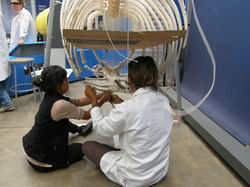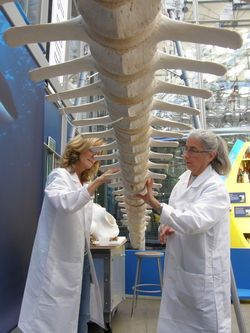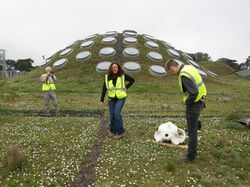
TheBoneman.com
Bone Building Books
Step-by-Step Guides for the Preparation and Articulation of Animal Skeletons
By Lee Post (a.k.a. Boneman)
Orca Skeleton Articulation Project- California Academy of Sciences
Just when I couldn't imagine a skeleton project getting any better, one did. In the spring of 2013, I was invited to go to San Francisco to work on an orca skeleton for an exhibit in a little place in Golden Gate Park, called the California Academy of Sciences. The exhibit tied into America's Cup sailboat race that was being hosted in San Francisco that summer. There was to be a 45-foot racing catamaran suspended in the museum, and corresponding exhibits having to do with the fastest ocean creatures.
 |  |  |
|---|---|---|
 |  |  |
 |  |  |
 |  |  |
 |  |  |
 |  |  |
 |  |  |
 |  |  |
This all started with an email I received from Jessica Brainard, exhibition development person, who had once previously worked at the Pratt Museum (our local natural history museum ), at a time when I was doing a collaborative Sperm Whale Project at the local high school. This was almost two decades earlier. She remembered me and contacted me to see if I might be interested in working on this whale project for the California Academy of Sciences, the following spring. But better yet, they wanted to open the project up to their volunteers, docents, and staff who were interested in helping to assemble the skeleton. Does a scientist take notes? Does an Alaskan appreciate warmer weather? (Not that it was any warmer in San Francisco most mornings or evenings.) Is glacier ice cold? Of course, I wanted to go!
This orca washed up near San Francisco. It was collected and cleaned by super staff leaders Moe Flannery and Sue Pemberton, along with lots of dedicated volunteers. They first had to haul it up a steep bluff and hike it out to the nearest road access. The whale's head alone weighed about 200 pounds. The whale was cleaned mostly by bacterial maceration in warm water and degreased and whitened with warm water (salt and fresh), detergents, and sodium perborate. The skull was further whitened by leaving it out in the weather on the living roof of the Academy. Thus the bones were as nice as they could be.
The exhibit designer people wanted to know if I could slow the project down to make it a two-month project. It would be a little incongruous trying to work in slow motion on an exhibit called BUILT FOR SPEED (plus I had to be back in Homer for a writers conference) so we ended up planning on it being a 30-day project.
I admit I was a little nervous about signing on with an institution as large and prestigious as the California Academy of Sciences, especially after I saw the fifteen-page contract I was given to sign that was full of legal language that contained parts I could only occasionally understand. But after visiting the Academy on a preview trip, and meeting the players, I was totally enamored by such a dynamic group of young, enthusiastic science-oriented people.
Now, this little museum in San Francisco only averages about 5000 visitors a day. The Orca Lab was going to be right smack in the middle of the museum behind some low, step-over barricades, and the public was going to be up close and personal. I couldn't imagine that we could make much forward progress in such an environment, but they had it pretty well thought out.
They signed up thirty-seven volunteers, a handful of staff organizers, and scheduled six workers a shift - two three-hour shifts a day - six days a week. Two of the volunteers at a time were "engagers." Their job each shift was to talk to and interact with the public and answer any questions they had, so the rest of us could make forward motion. I could come early or work late if I wanted. Anything I needed I just had to ask and - like magic - it would appear.
I kept waiting for the stuffy old guard to show up with a list of things I could and couldn't do. But if they were there they kept them well hidden because all I ever encountered were young, or young-at-heart, enthusiastic, science-obsessed, individuals who found their dream niche of a place to work. It was intoxicating being in a place where everyone I met was so enthused about whatever their particular passion was: the guy photographing spiders; the gal studying a particular genus of exotic nudibranchs; the Brazilian fish scientist there to study her genus of little fish from the collections; the scientific illustrator drawing botany specimens; the working student doing research on elephant shrews (who's even heard of elephant shrews?); the fifteen year old birding prodigy - it went on and on.
The goal - we were reminded - was to have the project last thirty days. Not any longer. Not any shorter. So I went through a daily exercise of crunching numbers and schedules and timelines trying to figure out where we were and where we should be. Alternately, I was convinced we were either going too fast - or there was no way we could get it done. A lot of this depended on how far we made it on that particular day. I had some tool-using super volunteers who could have single-handedly built the skeleton in two weeks, and others that were so careful and slow that it felt like no progress happened that shift. The game was to slow the super builders down and give confidence to the overly cautious ones so they would make forward steps. (Some of these volunteers were high school student science nerds. Hey, I was one myself once so could totally relate.)
Now this whale, being a relatively unknown ecotype Offshore Orca, is likely the only articulated skeleton on display of this type language, they live offshore in way bigger groups than the resident or transient killer whales we mostly know about. But most bizarre of all is the fact that the teeth of this whale were worn down to the gum line with pulp cavities exposed in many of the teeth. And this whale had yet to reach its teenage years (they can live as long as we do). While I was working on this whale in San Francisco, offshore orcas (which occasionally come close to shore) were being documented in Kachemak Bay (where I live in Alaska) for the first time ever. The whale scientists scooped up some floating matter from where those whales were feeding and identified it as sleeper shark liver (evidently a favorite food for these whales). Sleeper sharks have rough, tooth-like denticles in their skin which act just like sandpaper on the Orca Whale teeth, wearing them down quickly. Of course, this raises all kinds of unanswered questions such as. . . .
The project went smoother than a sea otter pelt, finishing up the last day at 4:30 PM, giving us barely enough time to put away our stuff before they whisked me off to the "orca skeleton completion party" and an amazing evening at Ray Bandar's house. Ray has the largest collection of skulls and osteological treasures I've ever heard of in one house - like over 1000 sea lion skulls alone - and that's just the sea lions. Some 7000 skulls live in that house. Look him up on Google.
Another fantastic project. Thank you California Academy people.